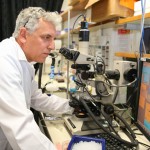Researchers Identify Key Protein in Parkinson’s Disease Spread
Jerusalem, 12 November, 2024 (TPS-IL) -- Israeli scientists have identified a promising new factor in the pathology of Parkinson’s disease that could pave the way for more effective treatments and genetic screening.
Parkinson’s, a neurodegenerative disorder affecting nearly 10 million people worldwide that occurs when certain nerve cells in the brain die or become impaired. It is known for effecting movement, cognitive skills, and causing mood swings, among other symptoms.
While previous studies focused extensively on the spread of the protein α-synuclein, researchers at Tel Aviv University discovered that another protein called TMEM16F facilitates the spread of α-synuclein.
“We found that a variant of the TMEM16F protein enhances the spread of Parkinson’s pathology through nerve cells in the brain,” said Dr. Avraham Ashkenazi, who led the study alongside PhD student Stav Cohen Adiv Mordechai. The findings were recently published in the peer-reviewed journal Aging Cell.
“A key challenge in Parkinson’s research has been understanding how the pathological version of α-synuclein propagates through the brain,” explained Mordechai. “Since this protein needs to cross cell membranes, we investigated TMEM16F, a membrane regulator, as a potential facilitator of this deadly process.”
The researchers created a mouse model lacking the TMEM16F gene and observed the behavior of neurons exposed to pathological α-synuclein. Remarkably, cells without TMEM16F exhibited a slower spread of the disease compared to those with the protein. This finding was further validated in live mouse models.
In collaboration with the Neurological Institute at the Tel Aviv Sourasky Medical Center, the team also investigated genetic variants of TMEM16F. They focused on Ashkenazi Jews, who trace their ancestry to Central and Eastern Europe, and have a higher incidence of Parkinson’s.
“We identified a specific TMEM16F mutation prevalent in this population, especially among Parkinson’s patients,” Ashkenazi said.
Cells carrying this mutation were found to secrete more pathological α-synuclein, accelerating the spread of the disease. The mutation appears to increase TMEM16F activity, which in turn affects membrane secretion processes.
The study’s findings mark TMEM16F as a promising target for new treatments. “If we can inhibit TMEM16F, we might reduce or even halt the secretion of defective α-synuclein, potentially slowing down the disease’s progression,” said Mordechai.
The most immediate application would be the development of drugs that inhibit TMEM16F activity. By blocking or modulating this protein, researchers may reduce the spread of pathological α-synuclein in the brain.
But the research also has the potential to lead to genetic screening tools that identify individuals at greater risk for Parkinson’s. The findings could also lead to insights into other neurodegenerative diseases, such as Alzheimer’s, where the spread of toxic proteins also plays a role.
While the initial results are promising, Ashkenazi cautioned that further research is needed.
“We still have many questions to answer,” he stressed.







